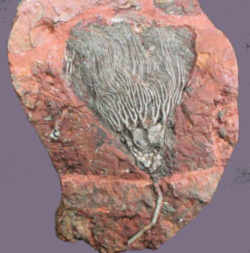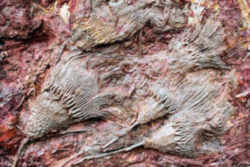
Missouri Symbols
Missouri State Fossil
Crinoid

(Delocrinus missouriensis)
Adopted on June 16, 1989.
The crinoid, (Delocrinus missouriensis,) became the state's official fossil on June 16, 1989, after a group of Lee's Summit school students worked through the legislative process to promote it as a state symbol.
The crinoid (Delocrinus missouriensis) is a mineralization of an animal which, because of its plant-like appearance, was called the "sea lily." Related to the starfish and sand dollar, the crinoid lived in the ocean that once covered Missouri. There are about 600 species alive in the ocean today. (RSMo 10.090)
Missouri State Fossil: Crinoid

Missouri's state fossil will always be unique, for it is the crinoid, (Delocrinus missouriensis.) This animal lived about
300 million years ago, during the Pennsylvanian Period.
Missouri's state fossil could almost pass for a state flower. It is one of a group of marine animals called sea lilies for their resemblance to plants.
Crinoid "flowers" are actually structures designed to filter tiny animals called plankton from the water.
Sea lilies are living fossils. Scientists thought they were extinct, until live sea lilies were collected in 1873. Most modern sea lilies are delicate
and colorful and live in colonies at depths of 600 to 1,500 feet (180 to 460 meters) but a few species live in waters less than 50 feet (15 meters)
deep. Some are 50 to 60 feet long. More than 5,000 extinct crinoid species have been described.
Crinoids are marine animals that make up the class Crinoidea of the echinoderms (phylum Echinodermata). Crinoidea comes from the Greek word krinon, "a lily", and eidos, "form". Crinoids are related to sea urchins and sea stars (or "starfish"). While urchins and sea stars can crawl about on the seafloor, crinoids are examples of echinoderms that are anchored to the sea floor by stalks. Animals that are so-anchored are termed sessile.
Crinoids first appeared on Earth by the early Ordovician Period, which began about 395 million years ago. During the Devonian, Mississippian, and Pennsylvanian periods, vast colonies lived in shallow seas. During the Paleozoic Era, they were among the largest and most abundant marine invertebrates. Entire crinoids and pieces of crinoids are preserved in fossils in limestone.
Missouri Law
The law designating the Crinoidea as the official Missouri state fossil is found in the Missouri Revised Statutes, Title 2, Chapter 10, Section 10.090.
TITLE II: SOVEREIGNTY, JURISDICTION AND EMBLEMS.
CHAPTER 10: STATE EMBLEMS.
SECTION 10.090.
10.090. The fossilized remains of Crinoidea, scientifically designated as Delocrinus Missouriensis, is declared to be the official state fossil of
Missouri.
(L. 1989 H.B. 515 § 1)
Taxonomic Hierarchy: Crinoidea
Kingdom: Animalia
Phylum: Echinodermata
Subphylum: Crinozoa
Class: Crinoidea Miller, 1821

Some states that lack a "state fossil" have nevertheless singled out a fossil for formal designation such as a state dinosaur, rock, gem or stone.






